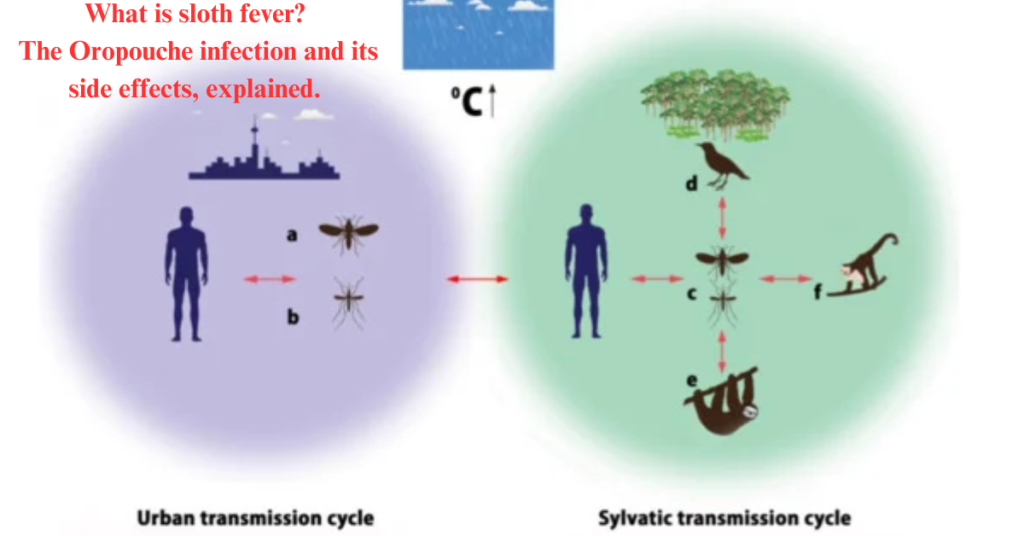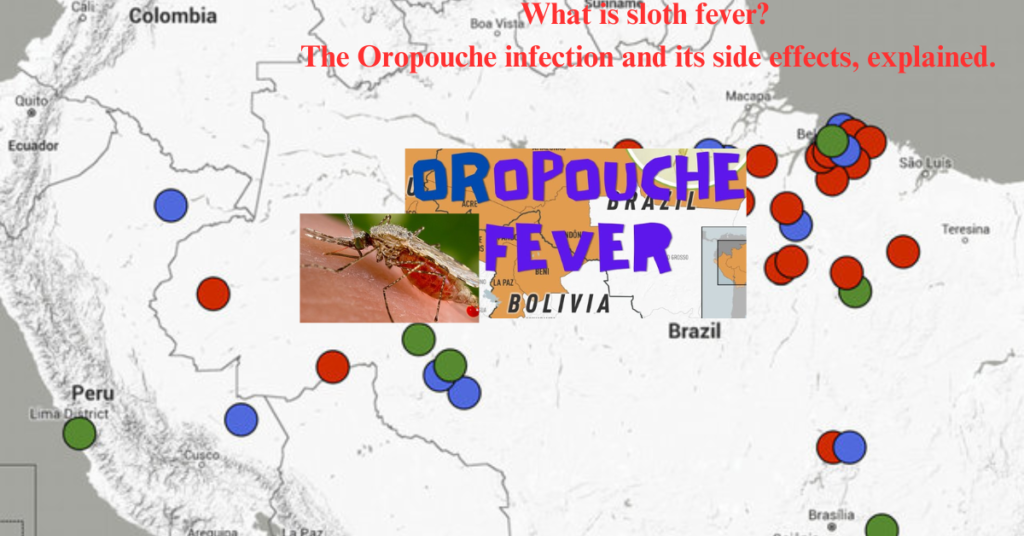
“Sloth Fever and Oropouche Infection: Exploring the Phenomenon and Its Top 10 Side Effects”
Table of Contents
What is sloth fever?
“Sloth Fever” is a colloquial term used to describe an intense, often irrational, fascination or obsession with sloths, the slow-moving mammals known for their laid-back lifestyle and adorable appearance. This phenomenon typically manifests as an overwhelming affection for sloths, leading people to collect sloth-themed merchandise, follow sloth-related social media accounts, or even visit sloth sanctuaries. Though not a medical condition, It is a playful expression of the deep admiration some individuals feel for these unique creatures.

Oropouche infection
The Oropouche infection is a viral disease caused by the Oropouche virus, which is primarily transmitted to humans through the bite of infected insects, particularly midges and mosquitoes. The virus is prevalent in tropical regions, especially in parts of South and Central America. Symptoms of the Oropouche infection typically include high fever, severe headaches, joint and muscle pain, nausea, and a rash. While the infection is generally not life-threatening, it can cause significant discomfort and, in some cases, lead to more serious complications, particularly if not properly managed
The Oropouche infection and its side effects, explained.
The Oropouche infection, a possibly lethal illness likewise alluded to as “sloth fever,” has advanced toward the US, inciting inquiries regarding what Americans ought to be aware.
On Tuesday, Florida’s wellbeing division revealed 30 instances of Oropouche fever in the express, all connected to go from Cuba. There has likewise been one case detailed in New York following travel.
In an update Tuesday, the CDC said no less than three of the underlying cases detailed in the U.S. were hospitalized and that the organization is “as of now fostering an arrangement for quick recognition and reaction” to the infection.
Recently, the Communities for Infectious prevention and Counteraction gave a wellbeing warning to tell clinicians and general wellbeing specialists of an expansion in the infection.
Between January 1 and August 1, 2024, in excess of 8,000 instances of Oropouche infection illness were accounted for, including two passings, the CDC alert expressed, adding nations revealing cases incorporate Brazil, Bolivia, Peru, Colombia and Cuba.
“No proof of nearby transmission at present exists inside the US or its regions,” the CDC added.

How is sloth fever sent?
Oropouche infection is spread to individuals fundamentally by the chomp of tainted gnawing midges (a kind of little fly) and mosquitoes.
As per the CDC, the infection is sent in forested regions among mosquitoes and non-human vertebrate has, for example, birds, rodents and sloths, which is where its moniker is determined. People then, at that point, become contaminated while visiting these regions and can acquaint the infection with metropolitan conditions.
Sloth fever can introduce much the same way to other mosquito-borne sicknesses like dengue or chikungunya fever, as indicated by the New York State Division of Wellbeing, which can make recognizing it trying.
The wellbeing office said most frequently side effects include:
Fever
Chills
Cerebral pain
Muscle a throbbing painfulness
Joint solidness
As per the CDC, different side effects can include:
Aversion to light
Unsteadiness
Torment behind the eyes
Queasiness
Retching
Rash
“Side effects regularly last under seven days (2-7 days) and can frequently repeat a couple of days or even weeks after the fact. The vast majority with Oropouche recuperate in the span of a few days to one month,” the CDC noted on its site. “Certain individuals (less than one of every 20) will foster more serious infection. This incorporates meningitis (aggravation of the films that encompass the mind and spinal rope), encephalitis (irritation of the cerebrum), or dying.”
Sloth fever treatment and avoidance
There are no antibodies to forestall or drugs to treat Oropouche, as indicated by the CDC. The most ideal way to safeguard yourself is keeping away from bug nibbles.
You can do this by utilizing bug repellant, utilizing window and entryway screens and utilizing a fan outside to fend bugs off, the CDC suggests.
The CDC is likewise suggesting that pregnant individuals keep away from trivial travel to areas of contamination, including Cuba and Brazil.

Effect of sloth fever on pregnant ladies
the infection is disturbing, particularly with regards to vertical transmission, or how it can pass to from mother to child in utero.
“It’s somewhat similar to Zika, where assuming that pregnant ladies are contaminated, it can cause fetal misfortune, intrinsic abnormalitie and such,” she said. “We’re currently at the earliest reference point of grasping that infection.”
This year, five instances of vertical transmission related with fetal passing or inherent irregularities have been accounted for, as per the CDC.
Conclusions
The Oropouche infection, though distinct in nature, both underscore the importance of understanding the impact of diseases and environmental interactions on human health. Sloth Fever, often used metaphorically, represents an obsession with sloths and the desire for a slower-paced lifestyle. In contrast, the Oropouche infection is a serious viral illness transmitted by insects, primarily affecting regions in South and Central America. The side effects of Oropouche infection, including fever, headaches, and joint pain, can significantly impact individuals and communities, especially in areas with limited access to healthcare.
Raising awareness about these conditions is crucial for different reasons—educating people on the Oropouche virus can lead to better prevention and treatment strategies, while understanding the cultural phenomenon of “Sloth Fever” can inspire conversations about the human-nature connection and the need for conservation efforts. Ultimately, both topics remind us of the complex interplay between health, environment, and culture, urging us to remain vigilant and informed in our rapidly changing world.





